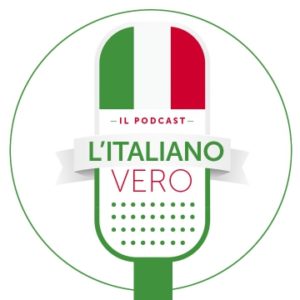
Blog in italiano – tempo di lettura: 4 min
Blog in English – reading time: 4 min
________________
Blog in italiano
Oggi puntata speciale, cari amici, visto che questa settimana si festeggia nientepopodimeno che (addirittura) il compleanno di Massimo! Per l’occasione io e Michela gli diamo spazio…e lui, “frizzante” come sempre, inizia intonando la celebre canzone “Champagne” di Peppino di Capri.
Michela nel frattempo programma le vacanze in Trentino, mentre la sottoscritta, da vera stacanovista non stacca dal podcast e resta al lavoro. (da Stachanov, nome del minatore russo che nel 1935 raggiunse, nell’estrazione del carbone, un massimo individuale mai raggiunto prima). Ne nacque un vero e proprio movimento, lo stacanovismo, diretto ad accrescere la produttività stimolando gli operai a un maggiore impegno.
Si usa la parola stacanovista per indicare una persona che lavora in modo indefesso, con eccessivo zelo e dedizione totale nello svolgimento di un lavoro.
Anche in senso ironico, proprio come l’ho usato io!
Salutiamo Pier, collega di Cubo e nostro ascoltatore “con le fette di salame sugli occhi”, visto che ha solo parole entusiastiche nei nostri confronti e non vede i difetti e gli errori!
27 luglio
1939 – Nasce Peppino Di Capri (81 anni fa): Caprese doc, dalla splendida isola del Golfo di Napoli, all’anagrafe Giuseppe Faiella, da oltre mezzo secolo è noto in Italia e all’estero come cantante di musica leggera. Fu scoperto per caso nel 1958 dagli impresari di una casa discografica milanese in vacanza a Capri!
Nella prima metà degli anni Sessanta sforna brani storici come Nessuno al mondo, Roberta, Nun è peccato e si afferma come “re del twist” italiano; degli anni Settanta, ricordiamo Un grande amore e niente più e Champagne.
Vincitore due volte del Festival di Sanremo (di cui detiene il record di partecipazioni, 15, insieme a Milva e Toto Cutugno).
28 luglio
1914 – Scoppia la Prima Guerra mondiale: Un mese dopo l’assassinio a Sarajevo dell’arciduca d’Austria Francesco Ferdinando per mano di un rivoluzionario bosniaco, l’Austria dichiara guerra alla Serbia.
Quella che inizialmente appare come una crisi isolata, si trasforma in poco tempo nel più grande e drammatico conflitto della storia. Vari fattori concorrono a far precipitare gli eventi: la forte ostilità tra Francia e Germania; la frenetica corsa agli armamenti tra il 1908 e il 1913; la rivalità tra le potenze colonialiste.
Sul campo si danno battaglia i grandi imperi centrali (Germania, Austria-Ungheria, Impero Ottomano e Bulgaria) e le potenze alleate (Francia, Regno Unito, Impero Russo, Serbia) a fianco delle quali si allea l’anno successivo (maggio 1915) l’Italia, dopo un aspro dibattito interno tra interventisti e neutralisti che spaccherà in due l’opinione pubblica. E’ una guerra di trincea perché dallo scoppio alla conclusione, si trasforma da guerra di movimento e attacco a guerra di trincea, di logoramento ad avanzare molto lentamente.
In Italia iniziano i primi scontri sul versante alpino tra l’esercito italiano e quello austro-ungarico. Due anni più tardi, nel novembre 1917 l’Italia subisce la più grave disfatta nella storia dell’esercito italiano a Caporetto, tanto che, ancora oggi il termine “Caporetto” è utilizzato come sinonimo di sconfitta disastrosa, fallimento. “Hai fatto una Caporetto!” significa “Hai fatto un vero disastro!”
L’ingresso degli Stati Uniti fa definitivamente pendere le sorti del conflitto a favore delle potenze alleate.
La guerra termina nel 1918 con un bollettino spaventoso: oltre 9 milioni di vittime militari, circa 7 milioni di vittime civili.
29 luglio
1981- Il principe Carlo sposa lady Diana: Il matrimonio del principe Carlo e di lady Diana Spencer ebbe luogo alla Cattedrale di Saint Paul di Londra.
Il Regno Unito stabilì una giornata di festa nazionale per celebrare l’evento.Il matrimonio della coppia venne visto come un “matrimonio da favola” e venne definito “il matrimonio del secolo”. Venne guardato alla TV da 750 milioni di persone, mentre furono seicentomila quelle che inondarono le strade di Londra per vedere la sposa durante il tragitto che l’avrebbe portata alla cattedrale. Lady Diana indossava un abito in taffetà e seta color avorio, adornato da pizzi antichi e con uno strascico lungo ben 7 metri.
Diana, proveniva da una delle più antiche e importanti famiglie britanniche, strettamente connessa con la Famiglia Reale da diverse generazioni. ma per l’opinione pubblica incarnò da subito l’immagine di ragazza semplice e lontana dalle etichette, insomma una novella Cenerentola che sposava il suo Principe Azzurro.
1 agosto
1972- Nasce Cubo!
E’ un piacere ascoltare Massimo mentre racconta della sua nascita a Montella! Ringraziando la sua ostetrica ;-) con i divertenti aneddoti del nostro caro Cubo, vi salutiamo e vi aspettiamo lunedì prossimo.
By Sara
►Ti piace il nostro podcast? sostienici al costo di un caffè
senza di voi non ci sarebbe il podcast:
https://www.patreon.com/litalianoveropodcast
►Contattaci per idee su nuovi episodi:
https://www.litalianovero.it/wp/contatti/
►Facebook:
https://www.facebook.com/litalianoveropodcast/
►Instagram:
https://www.instagram.com/litalianoveropodcast/
►YouTube
https://bit.ly/2zvrbOK
Blog in Inglese
Week from July 27th to August 2nd
Today is a special episode, dear friends, since this week we celebrate nientepopodimeno che (nothing less than) (even) Massimo’s birthday! For the occasion, Michela and I give him space … and he, “frizzante” (“bubbly”) as always, begins by singing the famous song “Champagne” by Peppino di Capri.
In the meantime, Michela plans her holidays in Trentino, while the undersigned, as a true stacanovista (workaholic), does not detach from the podcast and remains at work. (derived from Stachanov, name of the Russian miner who in 1935 reached, in the extraction of coal, an individual maximum never reached before. A real movement was born, the stacanovismo (workaholism), aimed at increasing productivity by stimulating workers to a greater commitment.
The workaholic word is used to indicate persona che lavora in modo indefesso (a person who works tirelessly), with excessive zeal and total dedication in carrying out a job.
Even in an ironic sense, just like I used it!
We greet Pier, Cubo’s colleague and our listener “con le fette di salame sugli occhi” (“with the slices of salami on his eyes”), since he has only enthusiastic words towards us and does not see the flaws and errors! (This is similar to the English expression: “to wear rose colored glasses” where everything always looks nice and colorful regardless of the reality.)
July 27
1939 – Peppino Di Capri (81 years ago) was born: Caprese doc, from the splendid island of the Gulf of Naples, registered name Giuseppe Faiella, has been known for more than half a century in Italy and abroad as a pop music singer. He was discovered by chance in 1958 by the impresarios of a Milanese record company on vacation in Capri!
In the first half of the sixties he churned out historical pieces such as Nessuno al mondo (Nobody in the world), Roberta, Nun è peccato (It’s not a sin) and he establishes himself as the Italian “king of the twist”; of the seventies, we remember Un grande amore e niente più (A great love and nothing more) and Champagne.
Winner of the Festival di Sanremo (Sanremo Music Festival) twice (of which he holds the record of 15, together with Milva and Toto Cutugno).
July 28
1914 – World War I broke out: One month after the assassination in Sarajevo of the Archduke of Austria Franz Ferdinando at the hands of a Bosnian revolutionary, Austria declares war on Serbia.
What initially appears to be an isolated crisis quickly turns into the biggest and most dramatic conflict in history. Various factors contribute to precipitate the events: the strong hostility between France and Germany; the frenetic arms race between 1908 and 1913; the rivalry between the colonialist powers.
On the field the great Central Empires (Germany, Austria-Hungary, Ottoman Empire and Bulgaria) and the Allied Powers (France, United Kingdom, Russian Empire, Serbia) are battling alongside which they ally with Italy the following year (May 1915), after a bitter internal debate between interventionists and neutralists that will split public opinion in two. It is a trench warfare because from the outbreak to the conclusion, it transforms from a war of movement and attack to a war of trenches, of wear and tear to progress very slowly.
In Italy the first clashes begin on the Alpine side between the Italian and the Austro-Hungarian armies. Two years later, in November 1917, Italy suffered the most serious defeat in the history of the Italian army in Caporetto, so much so that even today the term “Caporetto” is used as a synonym for disastrous defeat, failure. “Hai fatto una Caporetto! (“You made a Caporetto!”) means “Hai fatto un vero disastro!” “You made a real mess!”
The entry of the United States definitively tips the tide of the conflict in favor of the allied powers.
The war ended in 1918 with a frightening bulletin: over 9 million military casualties, about 7 million civilian casualties.
July 29
1981- Prince Charles marries Lady Diana: The wedding of Prince Charles and Lady Diana Spencer took place at London’s Saint Paul Cathedral.
The UK set up a national holiday to celebrate the event. The couple’s wedding was seen as a “matrimonio da favola” (“fairytale wedding”) and was called “il matrimonio del secolo” (“the wedding of the century”). It was watched on TV by 750 million people, while six hundred thousand people flooded the streets of London to see the bride on the way that would take her to the cathedral. Lady Diana wore an ivory-colored taffeta and silk dress, adorned with antique lace and with a train that is 7 meters long.
Diana came from one of the oldest and most important British families, closely connected with the Royal Family for several generations. but for public opinion she immediately embodied the image of a simple girl far from the labels, in short a fairy tale Cenerentola (Cinderella) that married her Principe Azzurro (Prince Charming).
August 1
1972– Cubo is born!
It is a pleasure to listen to Massimo as he talks about his birth in Montella! Thanking his midwife ;-) with the amusing anecdotes of our dear Cubo, we bid you farewell and look forward to seeing you next Monday.
By Kevin (ItalianRocks)
►Did you like the podcast? Please support us at the cost of a coffee
without you there would be no podcast:
https://www.patreon.com/litalianoveropodcast
►Contact us for ideas about new podcasts:
https://www.litalianovero.it/wp/contatti/
►Facebook:
https://www.facebook.com/litalianoveropodcast/
►Instagram:
https://www.instagram.com/litalianoveropodcast/
►YouTube
https://bit.ly/2zvrbOK
 Settembre 9, 2019
Settembre 9, 2019 24 min
24 min Luglio 29, 2019
Luglio 29, 2019 13 min
13 min Luglio 15, 2019
Luglio 15, 2019 24 min
24 min Luglio 1, 2019
Luglio 1, 2019 15 min
15 min Giugno 17, 2019
Giugno 17, 2019 21 min
21 min Maggio 30, 2019
Maggio 30, 2019 29 min
29 min Maggio 9, 2019
Maggio 9, 2019 21 min
21 min Aprile 30, 2019
Aprile 30, 2019 28 min
28 min Aprile 17, 2019
Aprile 17, 2019 15 min
15 min Aprile 10, 2019
Aprile 10, 2019 24 min
24 min Aprile 3, 2019
Aprile 3, 2019 24 min
24 min Gennaio 26, 2020
Gennaio 26, 2020 21 min
21 min Gennaio 12, 2020
Gennaio 12, 2020 20 min
20 min Dicembre 29, 2019
Dicembre 29, 2019 24 min
24 min Dicembre 15, 2019
Dicembre 15, 2019 21 min
21 min Dicembre 1, 2019
Dicembre 1, 2019 12 min
12 min Novembre 17, 2019
Novembre 17, 2019 min
min Novembre 3, 2019
Novembre 3, 2019 20 min
20 min Ottobre 20, 2019
Ottobre 20, 2019 14 min
14 min Ottobre 7, 2019
Ottobre 7, 2019 9 min
9 min Settembre 23, 2019
Settembre 23, 2019 33 min
33 min Gennaio 9, 2024
Gennaio 9, 2024 6 min
6 min Dicembre 2, 2022
Dicembre 2, 2022 31 min
31 min Ottobre 8, 2022
Ottobre 8, 2022 18 min
18 min Dicembre 25, 2021
Dicembre 25, 2021 1 min
1 min Settembre 18, 2021
Settembre 18, 2021 21 min
21 min Agosto 14, 2021
Agosto 14, 2021 17 min
17 min Maggio 4, 2020
Maggio 4, 2020 32 min
32 min Aprile 12, 2020
Aprile 12, 2020 41 min
41 min Agosto 26, 2019
Agosto 26, 2019 18 min
18 min Agosto 12, 2019
Agosto 12, 2019 11 min
11 min Giugno 5, 2019
Giugno 5, 2019 9 min
9 min







Leave a Comment